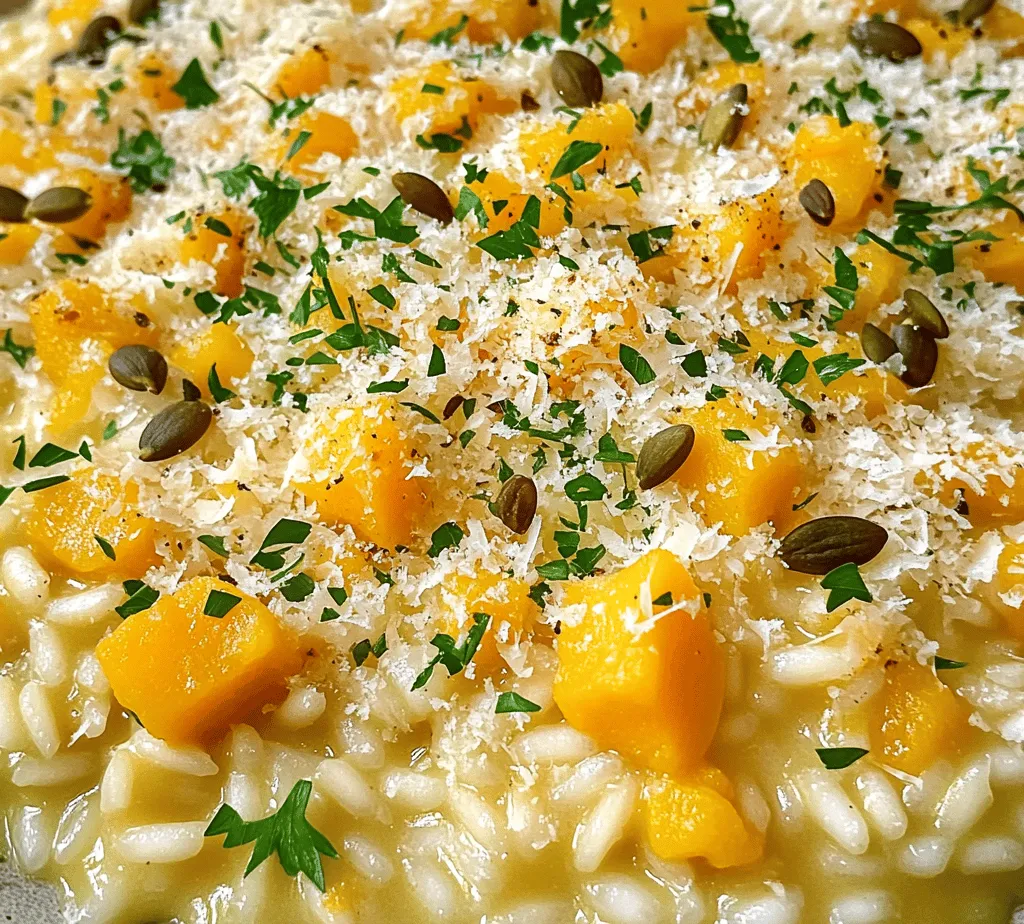Introduction
As the leaves turn vibrant shades of orange and gold, there’s an undeniable charm in the air that beckons us to the kitchen. What better way to embrace the richness of the autumn season than with a warm, comforting dish of risotto? This Italian classic is not only versatile but also a canvas for an array of seasonal ingredients. Among them, butternut squash stands out, bringing a touch of sweetness and a splash of color that perfectly complements the creamy texture of risotto.
Butternut Bliss Risotto embodies the essence of fall—its creamy, velvety consistency is enhanced by the natural sweetness of roasted butternut squash, making it a dish that warms both the body and soul. This recipe calls for wholesome ingredients, such as Arborio rice and fresh herbs, which provide depth of flavor and nutritional benefits. Simplicity is key here; the beauty of risotto lies in its straightforward preparation and the opportunity for customization. Whether you prefer to add a hint of spice or toss in some sautéed greens, this dish invites creativity and personal flair.
So, roll up your sleeves and prepare to indulge in a delightful cooking adventure that showcases the best of the season. Let’s dive into the world of risotto and explore how this Butternut Bliss Risotto can become a staple in your autumn menu.
Understanding Risotto: A Culinary Classic
Risotto has its roots deeply embedded in Italian cuisine, particularly in the northern regions where rice cultivation flourishes. This dish has evolved over centuries, becoming synonymous with comfort and culinary artistry. Traditionally, risotto is prepared using a specific type of rice known as Arborio, which is characterized by its short, plump grains and high starch content. This unique quality is essential for achieving the creamy, luxurious texture that risotto is celebrated for.
The process of making risotto requires a certain level of patience and technique, as it involves gradually adding liquid to the rice while stirring continuously. This method allows the rice to release its starches, creating that signature creaminess without the need for heavy creams or excessive fats. While it may seem daunting for novice cooks, the rhythm of slow cooking and attentive stirring is not only therapeutic but also rewarding. By embracing this culinary technique, you’ll discover that creating a perfect risotto is more about the journey than the destination.
Ingredients Breakdown
Butternut Squash
Butternut squash is the star of this dish, providing both flavor and nourishment. This winter squash is rich in vitamins A and C, fiber, and antioxidants, making it an excellent choice for a healthy diet. Its sweet, nutty flavor pairs beautifully with the creamy risotto, offering a pleasant contrast that is sure to please the palate.
When selecting butternut squash, look for firm, heavy squashes with smooth, unblemished skin. The color should be a deep, even tan. To prepare, start by peeling the squash with a vegetable peeler or sharp knife, then cut it in half lengthwise and scoop out the seeds. From there, you can cube the flesh into bite-sized pieces, ready for roasting or sautéing.
Arborio Rice
The backbone of any risotto is the rice, and Arborio rice is the variety of choice for this recipe. Its high starch content is what helps create that creamy texture without the use of additional dairy. Each grain absorbs flavors beautifully, making it the perfect vessel for the rich essence of butternut squash and herbs.
When working with Arborio rice, it’s important to note that it requires a bit more attention than standard rice varieties. The cooking process involves gradually adding broth and stirring, which helps the rice release its starches and achieve the desired creamy consistency. This attention to detail will reward you with a risotto that is both luxurious and satisfying.
Vegetable Broth and Almond Milk
To keep this Butternut Bliss Risotto vegan-friendly, we use a combination of vegetable broth and almond milk. The vegetable broth serves as the primary cooking liquid, infusing the dish with savory flavors. Opt for a low-sodium variety to control the saltiness of the final dish.
Almond milk adds a hint of creaminess and richness without the use of dairy. If you’re looking for a nut-free alternative, feel free to substitute with another plant-based milk, such as oat or soy milk. Together, these liquids enhance the flavor profile while maintaining the dish’s wholesome integrity.
Fresh Herbs and Seasonings
The magic of risotto lies not just in its ingredients but also in the herbs and seasonings that elevate its flavor. In this recipe, fresh thyme adds a fragrant note that perfectly complements the sweetness of the butternut squash. Garlic brings depth and aroma, while salt and pepper round out the dish, enhancing the existing flavors without overpowering them.
When using fresh herbs, always choose the best quality you can find. If thyme is not available, consider using sage or rosemary as alternatives—each will impart a unique flavor that brings something special to the dish.
Parmesan Cheese or Nutritional Yeast
For those who enjoy the traditional richness of risotto, freshly grated Parmesan cheese is the ideal finishing touch. It adds a salty, nutty flavor that beautifully complements the creamy texture of the dish. However, for a vegan option, nutritional yeast serves as a fantastic alternative, providing a cheesy flavor without any animal products.
When adding cheese or nutritional yeast, do so gradually, tasting as you go to ensure the flavors are well-balanced. This step is essential for achieving the perfect flavor profile that suits your personal preference.
Garnishes: Pumpkin Seeds and Parsley
To finish off the Butternut Bliss Risotto, consider garnishing with toasted pumpkin seeds and fresh parsley. Pumpkin seeds add a delightful crunch and a nutty flavor that contrasts with the creaminess of the risotto. They also contribute additional nutrition, being rich in magnesium and zinc.
Fresh parsley not only enhances the visual appeal of the dish but also adds a burst of freshness that brightens the overall flavor. Simply chop the parsley coarsely and sprinkle it over the risotto just before serving for an eye-catching presentation.
Step-by-Step Cooking Instructions
Now that we’ve covered the ingredients, let’s delve into the cooking process. Making Butternut Bliss Risotto is a rewarding experience that requires a bit of attention but yields delicious results. Here’s how to create your own creamy autumn delight:
1. Prepare the Butternut Squash: Preheat your oven to 400°F (200°C). Toss the cubed butternut squash with olive oil, salt, and pepper on a baking sheet. Roast for about 25-30 minutes, or until tender and caramelized, turning halfway through the cooking time. Set aside once done.
2. Sauté the Aromatics: In a large skillet or saucepan, heat 2 tablespoons of olive oil over medium heat. Add minced garlic and fresh thyme, sautéing for about 2-3 minutes until fragrant. Be careful not to burn the garlic.
3. Toast the Arborio Rice: Add 1 cup of Arborio rice to the skillet, stirring it into the garlic and herbs. Toast the rice for about 1-2 minutes until it becomes slightly translucent. This step enhances the nutty flavor of the rice.
4. Add the Broth Gradually: Begin adding the vegetable broth, one ladle at a time, to the rice mixture. Stir continuously, allowing the rice to absorb the liquid before adding more. This process should take about 18-20 minutes, and you’ll notice the rice becoming creamy as you stir.
5. Incorporate Almond Milk: Once the rice is al dente, stir in 1/2 cup of almond milk. This will add an extra layer of creaminess. Continue to stir for another 2-3 minutes, letting the flavors meld together.
6. Combine with Roasted Squash: Gently fold in the roasted butternut squash pieces, ensuring they are evenly distributed throughout the risotto. If desired, add grated Parmesan cheese or nutritional yeast at this stage, mixing thoroughly.
7. Season to Taste: Taste the risotto and adjust the seasoning with salt and pepper as needed. This is the time to ensure the flavors are just right for your palate.
8. Garnish and Serve: Transfer the Butternut Bliss Risotto to serving plates or bowls. Top with toasted pumpkin seeds and a sprinkle of fresh parsley for a beautiful presentation.
With these initial steps, you’ll be well on your way to creating a sensational Butternut Bliss Risotto that captures the essence of the autumn season. Embrace the process, enjoy the aromas wafting through your kitchen, and savor the rich, comforting flavors that await. Stay tuned for the next part of this article, where we’ll dive deeper into expert tips and answer common questions about making the perfect risotto!

Preparing the Broth Mixture
A key component of Butternut Bliss Risotto is the broth, which serves as the cooking liquid and flavor base for the dish. To ensure that the risotto cooks evenly, it’s essential to keep the broth warm throughout the cooking process. Warm broth helps maintain a consistent temperature in the rice, allowing it to release starches properly, which creates that creamy texture we all love in risotto.
To prepare the broth, you can use vegetable broth or chicken broth depending on your dietary preferences. Heat the broth in a saucepan over low heat, allowing it to simmer gently. This will keep it warm and ready for when you need to add it to the rice. If using vegetable broth, consider enhancing its flavor by adding herbs like thyme or bay leaves as it simmers. This extra step will infuse the broth with additional depth, making your risotto even more flavorful.
Sautéing Aromatics
With the broth prepared, it’s time to build a strong flavor foundation for the risotto. Begin by heating a generous amount of olive oil or butter in a large, heavy-bottomed pot over medium heat. Once the oil is shimmering, add finely chopped onions and sauté them until they become translucent, about 5 minutes. This process releases the natural sugars in the onions, creating a sweet and aromatic base for your dish.
Next, add minced garlic and sauté for another minute. Be careful not to let the garlic burn, as it can turn bitter. The combination of sautéed onions and garlic will fill your kitchen with an inviting aroma, setting the stage for the delicious risotto to come.
Incorporating Butternut Squash
Now it’s time to bring in the star of the dish: the butternut squash. Before you begin this step, ensure your butternut squash is peeled, seeded, and cut into small, even cubes. This uniformity is essential for even cooking.
Add the butternut squash cubes to the pot, stirring them into the aromatic mixture. Sauté for about 5-7 minutes until the squash begins to soften and caramelize slightly. The natural sugars in the squash will enhance the overall flavor profile of the risotto. If you want to add an extra layer of flavor, you can sprinkle a pinch of salt and a dash of nutmeg at this stage, as nutmeg pairs beautifully with squash.
Toasting the Rice
Toasting the rice is a crucial step in making Butternut Bliss Risotto. This technique helps to develop the nutty flavor of the rice and also allows the grains to better absorb the broth. Once the butternut squash is tender, add Arborio rice directly into the pot, stirring to coat the rice with the flavorful oil and vegetables.
Cook the rice for about 2-3 minutes, stirring continuously. You will notice the edges of the grains becoming translucent while the center remains opaque. This process not only adds flavor but also prepares the rice for its next step—the gradual absorption of broth.
Gradual Addition of Broth
This step is where the magic of risotto happens. Begin by adding the warm broth to the pot, one ladleful at a time. Stir the rice gently and continuously as you add the broth. This constant stirring helps to release the starches from the rice, resulting in a creamy consistency.
After each addition of broth, wait until it is nearly absorbed before adding the next ladleful. This gradual process typically takes about 20-25 minutes, and you should continue until the rice is al dente—cooked through but still with a slight bite. Taste as you go, adjusting seasoning with salt and pepper to your preference.
Finishing Touches
Once the rice is cooked to perfection, it’s time for the finishing touches that elevate the Butternut Bliss Risotto. Remove the pot from heat and stir in freshly grated Parmesan cheese or a dairy-free alternative if you’re aiming for a vegan option. This addition not only enriches the risotto but also adds a lovely creaminess.
Next, consider adding a bit of butter for richness, as well as a splash of lemon juice or zest to brighten the flavors. Taste again and adjust seasoning if necessary. Before serving, let the risotto rest for a couple of minutes. This resting period allows the flavors to meld beautifully.
Serving Suggestions and Pairings
When it comes to serving Butternut Bliss Risotto, presentation is key. Use a wide, shallow bowl to serve the risotto, which allows it to spread out and showcase its creamy texture. Garnish with freshly chopped parsley or sage for a pop of color and added freshness.
For a complete meal, consider pairing the risotto with a simple arugula salad dressed with a light vinaigrette. The peppery arugula complements the sweet butternut squash wonderfully, creating a well-rounded dining experience. Crusty bread, like a rustic sourdough or a baguette, is also an excellent addition for sopping up any leftover risotto.
As for beverages, a glass of chilled white wine, such as Sauvignon Blanc or Pinot Grigio, pairs beautifully with the dish. If you prefer non-alcoholic options, herbal teas or sparkling water with a twist of lemon can enhance the meal without overpowering the flavors of the risotto.
Nutritional Information and Dietary Considerations
Butternut Bliss Risotto is not just a comforting and delicious dish; it’s also packed with nutrients. A typical serving contains approximately:
– Calories: 350
– Protein: 10g
– Carbohydrates: 60g
– Dietary Fiber: 5g
– Fat: 10g
However, these values can vary based on the specific ingredients used, particularly the type of broth and cheese.
For those with dietary restrictions, Butternut Bliss Risotto can easily be adapted. To make it vegan, simply use vegetable broth and skip the cheese or substitute with a vegan cheese alternative. For a gluten-free option, ensure that your vegetable broth is certified gluten-free and stick to Arborio rice, which is naturally gluten-free.
Conclusion
Butternut Bliss Risotto is a seasonal dish that celebrates the sweet, nutty flavors of butternut squash while providing a comforting and creamy texture. This recipe not only highlights the joy of home cooking but also allows for creativity and variation, encouraging you to make it your own.
Whether you enjoy it as a hearty main dish or as a side to complement your favorite protein, this risotto is sure to become a favorite in your kitchen. The warming flavors and satisfying creaminess make it a delightful option for any occasion, especially during the autumn months when butternut squash is at its peak.
As you experiment with this recipe, consider incorporating other seasonal vegetables or herbs to create your unique twist. Cooking should be a joyful experience, so embrace the process and savor the delicious results that come from your kitchen.



